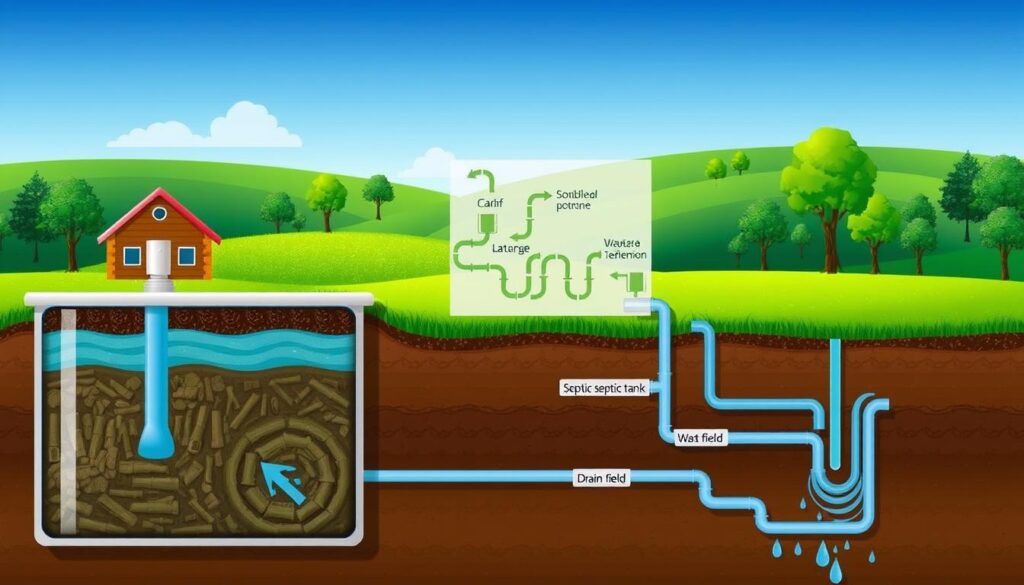Are septic systems a mystery to you? Many homeowners rely on these systems for wastewater management, yet misconceptions often surround their operation and maintenance.
Debunking septic system myths is crucial for homeowners to understand how to properly care for these systems. By addressing common misconceptions about septic systems, we can ensure they function effectively and efficiently.
Proper septic system maintenance tips can help prevent costly repairs and environmental hazards. This article aims to educate readers on the realities of septic system care, providing clarity on what works and what doesn’t.
Key Takeaways
- Understanding the basics of septic systems
- Identifying common myths and misconceptions
- Learning effective septic system maintenance tips
- Recognizing the importance of regular inspections
- Understanding the consequences of neglecting septic system care
Understanding Septic Systems: Facts vs. Fiction
Separating fact from fiction is crucial when it comes to understanding septic systems. Many homeowners are unaware of the proper care and maintenance required for these systems, often leading to costly mistakes.
The Importance of Proper Septic Knowledge
Having accurate knowledge about septic systems is vital for their longevity and efficiency. Proper septic care includes regular pumping, appropriate waste disposal practices, and routine inspections. For instance, regular pumping can prevent sludge buildup, which can lead to system failures. Proper maintenance not only saves money but also ensures the system operates effectively.
| Maintenance Task | Frequency | Benefit |
|---|---|---|
| Regular Pumping | Every 3-5 years | Prevents sludge buildup |
| Waste Disposal Checks | Ongoing | Reduces risk of system failure |
| Routine Inspections | Annually | Identifies potential issues early |
How Misinformation Leads to Costly Mistakes
Misconceptions about septic systems can lead to neglect and improper care. For example, believing that septic systems never need maintenance can result in system failures, which are not only costly but also hazardous to the environment. Understanding the facts can help homeowners avoid such pitfalls.
By understanding the facts and dispelling common myths, homeowners can ensure their septic systems are well-maintained. This not only prolongs the system’s life but also prevents costly repairs and potential environmental hazards.
7 Myths About Septic Systems You Shouldn’t Believe
Despite the facts, numerous myths surrounding septic systems continue to circulate, causing confusion among homeowners. These misconceptions can lead to poor maintenance decisions, potentially resulting in costly repairs or even health hazards. The seven common myths about septic systems that homeowners should be aware of include beliefs about maintenance needs, system longevity, and environmental impact.
Why These Misconceptions Persist
Misconceptions about septic systems persist due to a lack of understanding and misinformation. Many homeowners are unaware of how septic systems work, leading to misconceptions about their maintenance and functionality. Additionally, misinformation from unreliable sources can perpetuate these myths.
The Real Cost of Believing Septic Myths
Believing septic myths can have significant financial and environmental costs. For instance, neglecting regular maintenance due to the belief that it’s unnecessary can lead to system failures, requiring costly repairs. Moreover, misconceptions about septic systems can lead to practices that harm the environment, such as contamination of groundwater.
Myth 1: Septic Tanks Never Need to Be Pumped
The notion that septic tanks never need pumping is a common misconception that can lead to serious system failures. Regular maintenance is crucial for the longevity and efficiency of septic systems.
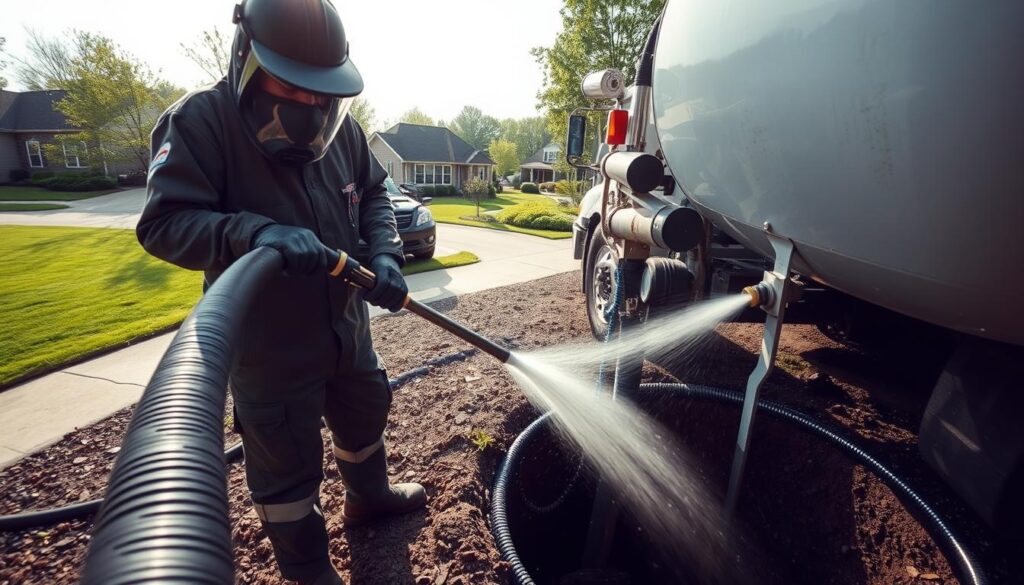
Origins of the “No Maintenance” Myth
The “no maintenance” myth likely originated from companies selling septic additives that claim to eliminate the need for pumping. These products often promise to break down solids and improve system performance without scientific backing.
In reality, having a septic tank pumped every two or three years is the best and most economical way to keep your system working. This regular maintenance helps prevent costly repairs and ensures the system operates as intended.
The Science Behind Sludge Accumulation
Sludge accumulation occurs as solid waste settles at the bottom of the septic tank. Over time, this layer thickens, reducing the tank’s effective capacity and potentially causing backups or system failures.
The rate of sludge accumulation varies depending on household size, water usage, and waste characteristics. Regular pumping is necessary to remove accumulated sludge and maintain system health.
Recommended Pumping Schedules for Different Households
Pumping schedules depend on several factors, including household size and water usage patterns. Generally, smaller households may require pumping every 5-7 years, while larger households may need it every 2-3 years.
| Household Size | Recommended Pumping Frequency |
|---|---|
| 1-2 people | Every 5-7 years |
| 3-4 people | Every 3-5 years |
| 5 or more people | Every 2-3 years |
By following these guidelines and understanding the importance of regular septic tank pumping, homeowners can avoid costly problems and ensure their septic systems operate efficiently for years to come.
Myth 2: Chemical Additives Are Essential for Septic Health
The notion that chemical additives are essential for septic health is a common misconception. Many homeowners believe that these additives are necessary to maintain a functioning septic system. However, the reality is that well-designed and properly maintained septic systems rely on natural bacterial processes to break down waste.
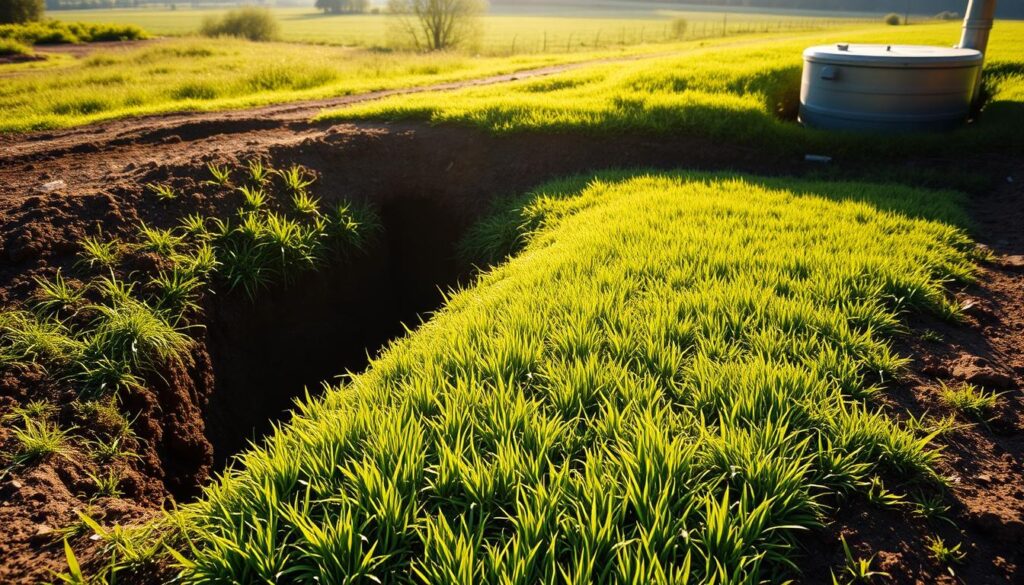
The Marketing Behind Septic Additives
The market for septic additives is driven by the promise of improved system performance and longevity. Companies often claim that their products enhance bacterial activity, reduce odors, and prevent system failures. However, these claims are frequently not supported by scientific evidence. The marketing behind these products often targets homeowners who are concerned about the health of their septic systems, preying on their fears and lack of knowledge.
It’s essential to scrutinize the claims made by manufacturers and look for evidence-based research to support their assertions.
What Research Shows About Bacterial Additives
Research on bacterial additives has yielded mixed results. Some studies suggest that these additives can temporarily increase bacterial activity, but there’s little evidence to show that they provide long-term benefits to septic system health. In fact, the U.S. Environmental Protection Agency (EPA) states that there’s no conclusive evidence that biological additives are effective in improving septic system performance.
The EPA’s stance on biological additives highlights the need for homeowners to be cautious when considering the use of such products.
Natural Processes vs. Chemical Interventions
Septic systems are designed to operate using natural processes. The bacteria present in the tank break down waste, and the system’s design allows for the natural filtration of wastewater. Chemical interventions, on the other hand, can potentially disrupt these natural processes. Instead of relying on additives, homeowners should focus on regular maintenance, such as pumping the tank and inspecting the system, to ensure their septic system operates effectively.
By understanding how septic systems work and maintaining them properly, homeowners can ensure their systems function correctly without the need for chemical additives.
Myth 3: “Flushable” Products Are Safe for Septic Systems
Despite their labeling, “flushable” products can pose significant risks to the health of septic systems. Many homeowners are unaware of the potential damage these products can cause, from clogging pipes to disrupting the delicate balance of their septic tank’s ecosystem.
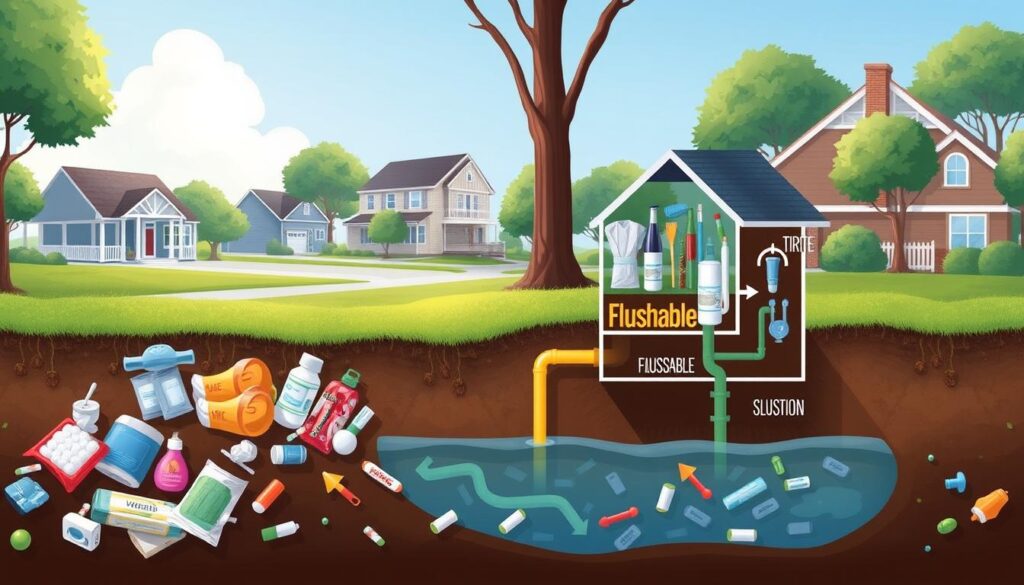
Decoding Product Labels and Claims
The term “flushable” is often associated with products like wipes, which are designed for personal hygiene. However, the definition of “flushable” can be misleading. Unlike toilet paper, which is designed to disintegrate in water, many “flushable” products do not break down as easily. This can lead to clogs and backups in household plumbing and septic systems.
When shopping for products that will be flushed, it’s essential to understand the differences between various types of wipes and other disposable products. Look for products that are specifically designed to be septic-safe, and be wary of products that claim to be “flushable” but do not provide clear guidance on their compatibility with septic systems.
How Non-Degradable Items Damage Your System
Non-degradable items, such as certain types of wipes and sanitary products, can cause significant problems for septic systems. When these items are flushed, they can accumulate in the septic tank and drainfield, leading to clogs and other issues.
| Product Type | Degradability | Potential Impact on Septic Systems |
|---|---|---|
| Toilet Paper | High | Minimal impact when used properly |
| “Flushable” Wipes | Low to Moderate | Can cause clogs and backups |
| Sanitary Products | Low | Can lead to significant clogs and system failures |
Creating a Septic-Safe Household Routine
To protect your septic system, it’s crucial to establish a septic-safe household routine. This includes being mindful of what you flush down the toilet. Avoid flushing non-degradable items, and opt for products that are designed to be septic-safe.
- Only flush toilet paper and human waste.
- Avoid using “flushable” wipes and other products that are not designed for septic systems.
- Regularly inspect your septic system to catch any potential issues early.
By being informed and taking proactive steps, homeowners can significantly reduce the risk of problems with their septic systems. This not only helps in maintaining a healthy septic system but also contributes to a more sustainable and environmentally friendly household practice.
Myth 4: All Septic Systems Inevitably Smell Bad
Septic systems are often associated with unpleasant odors, but in reality, a well-functioning system should be virtually odorless. The design of septic tanks aims to contain and treat wastewater in a way that minimizes odor. Understanding why septic systems should be odorless and how to address any odor issues is crucial for homeowners.
Why Functioning Systems Should Be Odorless
A properly functioning septic system is designed to process wastewater efficiently, reducing the likelihood of noticeable smells. The natural processes within the septic tank, including bacterial breakdown of waste, are intended to minimize odors. Regular maintenance is key to ensuring that the system operates as intended.
Key factors contributing to an odorless septic system include:
- Regular pumping and inspection
- Proper waste management
- Avoiding excessive water usage
- Not disposing of non-biodegradable items through the septic system
Common Causes of Septic Odors
Despite the design of septic systems to be odorless, smells can occur due to various reasons. Common causes include neglect of regular maintenance, excessive water usage, and the presence of non-biodegradable materials in the system. Understanding these causes can help homeowners take corrective actions.
| Cause of Odor | Description | Solution |
|---|---|---|
| Neglect of Maintenance | Failure to pump the septic tank regularly leads to sludge buildup and potential backups. | Schedule regular inspections and pumping as needed. |
| Excessive Water Usage | Too much water can overload the septic system, causing it to malfunction. | Implement water-saving measures and fix leaks promptly. |
| Non-Biodegradable Items | Items that do not break down can cause clogs and backups. | Avoid flushing non-biodegradable items. |
Troubleshooting Unexpected Smells
If your septic system starts to produce unpleasant odors, there are several steps you can take to troubleshoot the issue. First, check for any signs of backups or leaks. Ensure that your system has been properly maintained, and consider having a professional inspect the system if the smell persists.
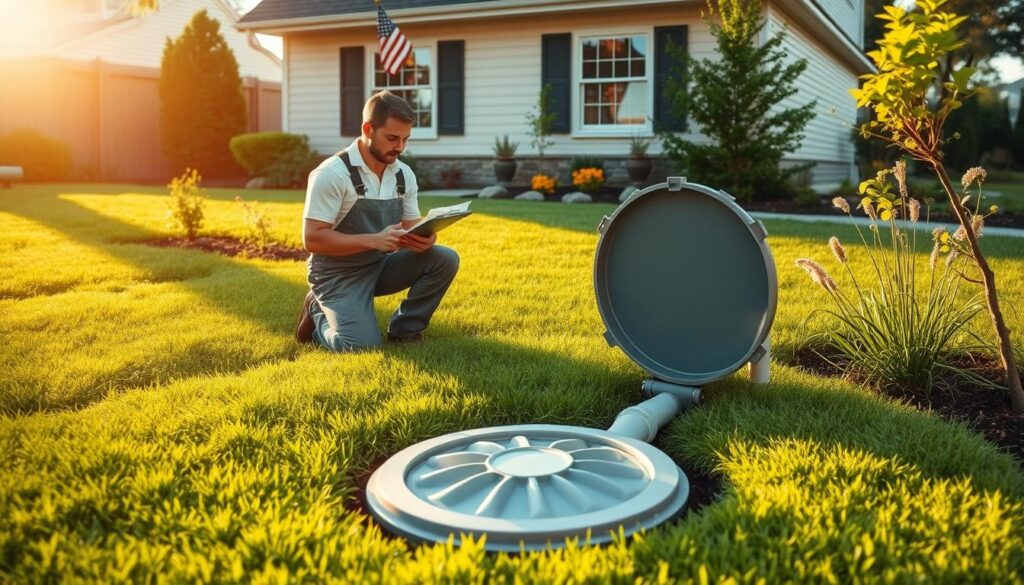
By understanding the causes of septic odors and taking proactive steps, homeowners can maintain a healthy, odorless septic system. Regular maintenance and proper usage are key to preventing odor issues.
Myth 5: Older Septic Systems Cannot Perform Efficiently
The efficiency of a septic system is not solely determined by its age, contrary to popular belief. Many septic systems continue to function perfectly well even after two decades of service. In fact, there are instances of septic systems still working efficiently after 49 years, highlighting that management and maintenance play a much more significant role in their longevity than an arbitrary lifespan expectation.
Lifespan Realities of Well-Maintained Systems
Well-maintained septic systems can outlast many expectations. Regular maintenance, including pumping and inspections, significantly extends their operational life. It’s essential for homeowners to understand that with proper care, a septic system can be a long-term solution for wastewater management.
Factors such as the size of the household, water usage, and the system’s design influence its lifespan. For instance, a larger household may require more frequent pumping, while a well-designed system can mitigate potential issues.
Rehabilitation Options for Aging Systems
For aging septic systems showing signs of inefficiency, rehabilitation is often a viable option. This can involve repairing or replacing damaged components, such as the drain field or inlet/outlet tees. In some cases, adding new technology or upgrading the system can significantly improve its performance.
Rehabilitation not only extends the system’s life but can also enhance its environmental performance by improving wastewater treatment efficiency.
When Replacement Actually Becomes Necessary
Despite maintenance and rehabilitation efforts, there comes a point when replacement is necessary. This decision is typically based on the system’s condition, its ability to meet current wastewater demands, and compliance with regulatory standards.
Homeowners should be aware of the signs indicating a need for replacement, such as frequent backups, persistent odors, or failure to pass inspections. Consulting with a professional can help determine the best course of action.
Myth 6: Septic Systems Are Environmental Hazards
Contrary to popular belief, properly functioning septic systems can be an environmentally friendly solution for wastewater management. Septic systems are designed to treat wastewater in a way that minimizes environmental impact.
Understanding the Natural Filtration Process
Septic systems work by utilizing natural processes to treat wastewater. The wastewater flows into the septic tank, where solids settle and are broken down by bacteria. The liquid then moves to the drain field, where it’s filtered through the soil, removing harmful bacteria and viruses.
Natural Filtration: The soil acts as a filter, removing pathogens and contaminants from the wastewater, making it safer for the environment.
Environmental Benefits of Properly Functioning Systems
When functioning correctly, septic systems can provide several environmental benefits. They help to maintain groundwater quality by filtering out contaminants from wastewater. Additionally, properly maintained septic systems can be a cost-effective and sustainable way to manage wastewater.
| Environmental Benefits | Description |
|---|---|
| Groundwater Protection | Filters out contaminants from wastewater, maintaining groundwater quality. |
| Cost-Effective | Properly maintained septic systems can be a sustainable and economical solution. |
| Sustainable Wastewater Management | Utilizes natural processes to treat wastewater, reducing environmental impact. |
Preventing Potential Contamination Issues
While septic systems are designed to be environmentally friendly, there are steps that can be taken to prevent potential contamination issues. Regular maintenance, such as pumping the septic tank and inspecting the system, is crucial.
Regular Maintenance: Ensures the system operates correctly, reducing the risk of contamination.
Myth 7: You Can’t Landscape or Build Near Septic Systems
The idea that you can’t landscape or build near a septic system is a common misconception that can unnecessarily restrict your property’s potential. While it’s true that septic systems require careful consideration, understanding the facts can help you make the most of your land.
Safe Distances for Structures and Activities
When it comes to building or landscaping near a septic system, maintaining safe distances is crucial. The minimum distance between a septic tank and a house is typically 10 feet, but this can vary based on local regulations and the size of your system. For drain fields, it’s recommended to keep buildings or hardscapes at least 20 feet away to prevent damage and ensure proper function.
| Structure/Activity | Recommended Distance from Septic System |
|---|---|
| House or Building | 10-20 feet |
| Drain Field | Keep 20 feet away from buildings or hardscapes |
| Swimming Pools | At least 20 feet away |
| Water Wells | At least 50-100 feet away, depending on local regulations |
Beneficial Plants for Septic Drain Fields
Choosing the right plants for your septic drain field can enhance its performance and longevity. Grasses are an excellent choice because they help to distribute the wastewater evenly and prevent erosion. Other beneficial plants include sedges and wildflowers, which are not only aesthetically pleasing but also help to maintain soil health.
Landscaping Practices That Protect Your System
To protect your septic system, avoid planting trees or shrubs with deep roots near the drain field, as they can damage pipes. Also, refrain from driving or parking over your septic system, as this can compact the soil and damage the tank or pipes. Regular septic system care includes being mindful of what you dispose of down the drain and scheduling regular inspections.
By following these septic system maintenance tips and being aware of the dos and don’ts of landscaping near your septic system, you can ensure its longevity and efficiency, debunking the myth that you can’t build or landscape near these systems.
Conclusion: Maintaining a Healthy Septic System Based on Facts
Understanding the truth behind common septic system myths is essential for proper maintenance and care. By being informed, homeowners can take necessary steps to maintain a healthy septic system.
Dispelling septic system myths and focusing on facts is crucial for effective septic system care. Regular maintenance, proper waste disposal, and being aware of the system’s limitations can significantly extend its lifespan.
To keep your septic system functioning properly, follow septic system maintenance tips such as regular inspections and pumping. Being mindful of what you flush and avoiding chemical additives can also contribute to a well-maintained system.
By separating facts from myths in septic systems, homeowners can avoid costly mistakes and ensure their system operates efficiently. Proper septic system care not only protects your property but also the environment.

